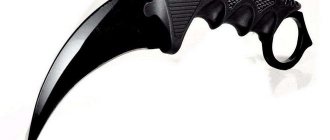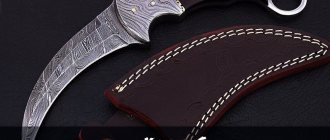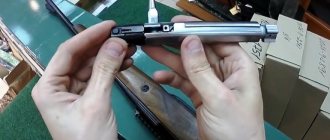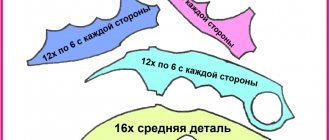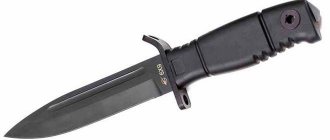The karambit knife is a traditional weapon of the peoples living in the Malay Archipelago. According to two existing versions regarding the shape of the knife blade, it is called a tiger claw, and according to another, it is called a rooster’s paw. During cockfights, which the Malay people love, they put spurs on the bird’s paws, reminiscent of a karambit blade. Therefore, it is impossible to determine exactly what appeared first: the knife or the spurs.
Seeing it for the first time, it may seem like a terrible, deadly device. But in reality everything looks a little different. Depending on their form, they are divided into household and combat types. Even women use it for self-defense; the military uses it when the main weapon is broken or lost. In this case, this adaptation becomes the last chance for survival.
What is the origin of karambit?
Household elements and various objects that are decades old have their own stories of origin. For example, the legend describing the origin of karambit is associated with buffalo fights.
Different tribes resolved their conflicts with the help of buffalo fights, and accordingly, the tribe whose buffalo won won. In the next conflict, a tribe from the islands of Java and Sumatra fought for victory.
Thus, the inhabitants of the island of Java chose a powerful and aggressive animal for the competition, and the inhabitants of the island of Sumatra approached the choice of an opponent from a completely different angle - a small calf was chosen for the competition.
The peculiarity of the calf was that small broken-shaped blades were tied to its horns, like those of a modern karambit.
In addition, the little calf was not fed before the fight. But an adult and aggressive buffalo did not see a threat in the calf standing opposite, so it did not even attack it. And the hungry baby mistook the buffalo for a buffalo and rushed towards him in search of milk, inflicting cutting wounds on the buffalo, which led the baby to victory.
But there are other versions of the appearance of this weapon. So, seven centuries ago, on the Indonesian island of Java there lived a population who believed in the transmigration of souls. After the death of King Pak Makan, local residents decided that his respected spirit was distributed in all types of tigers, since they personified a collective image of power and strength.
And in honor of all the tigers, the aborigines began to create knives shaped like a claw, which is the prototype of the modern karambit.
Black Karambit knife.
After some time, such weapons were used on the island of Sumatra and were used for various purposes:
- for hunting;
- Agriculture;
- self-defense;
- cockfights, where curved spurs were tied to the paws, which in appearance resembled karambit.
In the Malay Archipelago, a statue of one of the kings of the tribe is represented with such a knife in his hands. The symbolism of the karambit knife is used on the emblem of the Malayan detachment.
History of origin
The first knives of the karambit type have been known since the 14th century. But there is no reliable information about its origin. The authorship is mainly given to the Minangkbau people, who used these devices during battles with their neighbors over land territories.
They were also needed to solve everyday problems: removing and processing skins, cutting up animal carcasses and fish. They were used to peel vegetables, fruits, cut small branches, etc. Combat and utility types of knives differed in blade size, handle shape, and purpose, of course.
According to other versions, the prototype of modern karambit was:
- Malay agricultural implement sickle.
- Spurs that fit on the paws of a rooster.
- A type of Indian brass knuckle knife.
Where the truth is here is unknown, but the history of the karambit knife concerns the territory of Malaysia, where it is also called the “tiger claw”, because the shape of the blade is very similar to it.
What does a knife look like and what are its features?
The main function of karambit is self-defense; it was created in this particular form exclusively for inflicting piercing, cutting wounds and blows.
What shape does the blade and its handle have?
The unconventional shape of the handle and blade attracts attention with its unusualness. The blade is curved so much that it resembles the claw of an adult predator. The blade is of medium length and is sharpened on one side only. It is extremely rare to find a blade whose length is 10 cm.
The ring on the handle makes this knife stand out from others. You can find models that have a hole for your fingers, which allows you to use a more secure grip. The unusual shape makes it possible to twist it, take it with a reverse grip, placing the little finger or index finger in the hole, or simply hold it straight.
The tenacious grip leaves no chance for the enemy to knock the weapon out of his hand, and thanks to the securely fastened hand, there is no danger of getting hurt.
The handle of the knife is made of wood, fastened with one or a series of rivets. In improved versions of the model, you can see a small spike, which is used as a poking weapon.
Karambit claw knife with wooden handle.
How to do it yourself
You can try to make such a beautiful blade yourself from paper, cardboard, plywood and wood. You will get an exact copy of the blade, as in the popular computer game. It is imperative to perform all actions in order to avoid mistakes.
Create a drawing
Before creating a drawing of a karambit knife, select the model you want to make. Dimensions are taken. If you wish, you can find a ready-made drawing of the blade and print it or trace it along the contours directly on the monitor screen. A simple drawing is drawn on paper on a scale of 1:1. For this, a sheet of thick paper with A4 format will be enough.
Making a knife
Making a popular knife with a drawing is quite simple. Now you need to prepare the materials for the work from which the knife and tools will be made.
From paper
To work you need to prepare:
- several sheets of paper, the color can be any desired; for contrast, the handle can be made in a different color;
- scotch;
- marker;
- pencil;
- scissors and PVA glue or hot melt glue.
Making a blade from paper is done step by step:
- In the drawing, the knife is divided into three parts: the blade, the handle to the ring and the ring.
- Cut out these three parts carefully with scissors.
- To make the handle, fold a sheet of A4 paper in half, then in half again (1/4), and again (1/8) to make a rectangle out of the paper.
- Apply the handle template to the folded paper so that the top of the template is on the top solid part of the fold of the sheet. Trace with a pencil and cut along the contour, without touching the upper solid part of the fold.
- The resulting “book” of eight leaves is glued together. The middle doesn't stick together. It turns out a handle with a bend.
- Glue the handle completely, except for 3 cm along the edge where it joins the blade. This part remains to strengthen the edge.
- To make a knife blade, fold the paper in the same way as in step 3 for the handle.
- The template is traced according to the same pattern as that of the handle and cut out, after adding 2 cm at the wide part for easy joining with the handle.
- Glue the parts except the middle.
- To fasten, take a square sheet of paper, place a thin rod from a pen on the edge and roll the paper along the rod into a thin tube. Twist the tip of the paper and glue it with tape so that everything does not unravel.
- The rod is removed from the resulting structure, the workpiece is smoothed with your fingers and 2 pieces of 10 cm and 5 cm are cut off - these are the fastenings for the blade and handle.
- The blade is connected to the handle using fasteners and glued together.
- For the third part of the ring, form the same structure as in step 10. Only from it the ring is twisted and glued to the handle.
Made of wood
The option of making karambit from wood is complex, it is suitable for those who have skills in working with wood. The type of wood suitable for work is linden. The size of the workpiece should be slightly larger than the future dimensions of the knife. The linden must first be dried; it should not have cracks or holes from knots. To work you will need:
- drills of different sizes;
- chisels of different shapes;
- vice;
- different knives with carbon steel blades.
When making a blade from wood, they use a sketch drawing, as well as their spatial imagination:
- The drawing is transferred to cardboard, a template of three parts is cut out: the main part of the blade and handle and two shaped attachments.
- The template is transferred to a wooden blank and cut out.
- The handle hole is cut with a feather drill or jigsaw.
- The finished parts are glued together with PVA glue and clamped in a vice for a day until dry.
- The last thing to do is sanding until completely smooth.
Coloring
The finished model of the knife can be painted like a real karambit for role-playing. Options are selected at will from the popular computer game, which was mentioned at the beginning of the article Counter-Strike: Global Offensive. Acrylic paints are chosen for painting. They have advantages:
- they do not get dirty and dry quickly;
- paints are harmless.
The most popular blade coloring options:
- Murder and Bloody Web - in black and red;
- Tiger tooth - the blade and ring are painted to resemble the skin of a tiger;
- Gamma wave – black malachite color, and many others.
Using the skins system, it’s easy to stylize this blade.
Gamma wave
Bloody Web
Tiger tooth
What types of karambit are there?
As a rule, there are two main types of these weapons:
- With a fixed blade.
- Folding.
It is more convenient to carry a folding karambit knife; the clip adds convenience; with its help you can carry the knife on your belt. For folding karambit, special small and lightweight plastic holders are made.
And for a non-folding model, the manufacture of a unique sheath is required. The knife case is made of soft leather so that it can be easily and firmly put on. While the blade is inside the case, the ring remains on the outside.
Peculiarities
The main feature of the blade is its curved shape, which in appearance may resemble an animal claw. The blade itself is no more than 9 centimeters in length. It is sharpened only on one side - the inner one.
The knife is used to inflict piercing or cutting wounds. The main target was to hit the arteries, tendons and muscles. Karambit is widespread in its homeland - in the Malay Archipelago, but its popularity is growing every year and, in addition to its region, it is beginning to enjoy success in other countries.
Another important point is the presence of a special finger ring, which helps to better hold the knife in your hand. Thanks to the unique structure of the handle, the weapon can be held in a reverse or forward grip.
Modern knives can be folding or non-folding. The first option is more convenient, as it makes the karambit significantly smaller, but at the same time its service life is reduced. The folding version also has a special clip so that it can be attached to a belt. For convenience, special holders are also sold.
For a non-folding model, a sheath is required. They are made according to the size and shape of the weapon. The best option is leather material.
Knife in hand
Karambit-like knives
Year after year there are masters who try to improve the karambit knife. Of course, after modernization, the knife acquires new elements and becomes more of a karambit-like knife, the functions of which are not actually changed, but the appearance is different.
What are the famous karambit-like knives:
- Taji is the common name for knives that are intended for cockfighting. This “amusing” business dates back to Indonesia, where knives were attached to the paws of roosters using red string. Taji knives are razor-sharp and their length is from 10 to 15 cm. Craftsmen make entire sets of 6-12 knives in a set of different lengths, designed for different sizes of roosters. Taji knives are considered not only sports, but also sacred equipment. It is customary to clean Tajis only at night and only for men; women are prohibited from touching them;
- Kuku Mahan literally means “Claw of the Great Tiger”. Its difference from a traditional blade is that it has less curve in the blade;
- Karambit Lavi Ayam is also intended for “cockfighting”. The second name of the blade is “cockspur”;
- Kembar - its difference is that this blade has two blades that are directed in one direction;
- Renkong - has a slight bend in the blade, a small protrusion near the handle;
- Panjang - has a slightly curved blade, with a sharp protrusion on the outside;
- Minang is a sickle-shaped knife with a tiger on the handle or sheath.
Minang sickle knife.
Real effectiveness of a curved blade
Learning to use karambit is not difficult now. In a large city there will definitely be a martial arts school where they will teach you this. As a last resort, you can learn the basics from video lessons. But what is this for? Of course, in Malaysia, every scratch can become inflamed within a couple of hours. A series of such cuts will cause the opponent to lose a lot of blood and abandon the attack. In Russia, where people wear thick clothes most of the year, karambit is ineffective.
If you still don’t want to give up your dream, we can recommend hitting your legs in self-defense; jeans or “sweatpants” are not the best protection from a sharp blade. It is better not to use a knife in a conflict at all, and if life is really in mortal danger, use a normal blade.
Karambit knives have an ancient and interesting history, but they are only suitable for self-defense in the hot season. It will be very difficult to cut food with them.
Advantages and disadvantages, practical application of karambits
All types of bladed weapons have their advantages and disadvantages. The advantages of karambit include :
- compactness;
- can easily be hidden unnoticed under clothing;
- when using, the knife can be held with a forward or reverse grip;
- the originality of the shape of the blade gives a certain superiority during the battle;
- a ring on the handle, with its help you can easily rotate the weapon (for combat tactics or psychological influence).
But where there is originality, there is also specificity, since in order to wield this edged weapon, you need to gain experience and get used to it.
The disadvantages of karambit include:
- it is difficult to sharpen;
- quite uncomfortable to wear;
- it takes a lot of strength to strike directly;
- It's hard to take out and put into the sheath.
Karambit: classification and use of a combat knife
The knife, called karambit , has a curved (sickle-shaped) blade and, as a rule, the same curved handle, equipped with one (less often, two) rings. This type of knife has always been traditional for the people of Indonesia, where it was widely used in both combat and peaceful situations.
Today, this type of knife has gained wide popularity (largely thanks to films and computer games, where karambit is sometimes presented as almost a super weapon) and is produced in one form or another by most large knife companies. Today we will try to talk about what this knife can be and whether it is really as good as they say about it.
The content of the article
Karambit options
All the endless variety of models of this knife (and famous manufacturers also produce it) can be reduced to two main variations - for a direct grip and for a reverse grip.
Karambit for direct grip
Knives of the first type have a built-in ring (for the index finger), located exactly in the middle (that is, in the place where a regular knife would have a bolster or guard - at the transition of the handle to the blade). This allows you to securely hold the knife both when performing cutting, secant and piercing blows.
Karambit of this type (despite their somewhat less popularity) has greater versatility and in certain situations can well be used as a household knife.
Reverse grip karambit
Knives of the second type - designed for a reverse grip - have a ring located at the end of the handle, as well as a more curved blade (as a rule, both the handle and the blade have the same bend radius, although there are other options).
Such a karambit is convenient to hold with both a direct and reverse grip (although the latter is still more convenient in a “combat” situation due to their specific balance). Knives of this type are more convenient for self-defense, for making deep cuts and cutting blows, but have practically no practical application (it is unlikely that such a blade will be able to cut food or trim a branch).
Folding karambits
In addition to the “classic” versions of karambit with a fixed blade, there are also folding karambits. They, as a rule, have significantly smaller dimensions, but can also be made both under a direct and under a reverse grip (in the first case, the ring is most often made integral with the folding blade). By the way, among folding models there are sometimes quite rare varieties of traditional karambit, for example, knives with two blades pointing in different directions (this version has the Indonesian name “kembar”).
Speaking about folding versions of the traditional Indonesian knife, one cannot fail to mention some modern models that are not directly karambits (due to a less pronounced overall bend or the absence of a ring), but at the same time clearly have their origins from them. Such “karambit-like” knives are, for example, the famous Spyderco Civilian or the equally famous Hannibal Lecter knife - Spyderco Harpy.
Additional options
As with many other knives, on some models of karambits, in addition to the blade itself, there are additional structural elements that expand their functionality and combat potential.
On many classic karambits, the role of such an “additional element” was played by a special protrusion (spur or spike), located on the outer side of the ring of knives for a reverse grip. In a combat situation, depending on the version, it could play the role of either an additional small piercing blade or the role of a skullcrusher. On many modern knives this protrusion is also present, but most often in the form of a more “peaceful” device - a flat screwdriver or glass breaker (which does not prevent, in case of emergency self-defense with a karambit in hand, using this “screwdriver” for crushing blows). Other, more modern, innovations used in the manufacture of these knives include openers, hooks for gutting game and sling cutters integrated into the blade. How appropriate they are specifically for karambits is up to everyone to decide for themselves when purchasing such a knife. We will only add that you can find similar products, for example, from the Fox company.
Among other features of karambits, knives with serrated sharpening should be noted. Most often, karambits with a direct grip have it, but it is also found on knives with a reverse grip. Depending on the type of notch, this serrator can have both a utilitarian purpose (for example, for cutting ropes or more convenient cutting of hard products) and a purely combat purpose (most of all this applies to options with a needle serrator).
On some modern models you can also find a semi-serrator. In this case, as a rule, the part of the blade closest to the tip is sharpened with plain, and the half located closer to the handle has serrated teeth.
Practical application of karambit
Above, we have already mentioned in passing that karambit is not the most ideal option for use as a utility knife. The shape of its blade, combined with the additional bend of the handle and specific grips, is unlikely to be as convenient for planing, cutting or cutting anything as a knife with a regular straight blade.
As for the “combat” use of this knife, it also has its own characteristics. So, the first thing worth noting in this case is the great difficulty of delivering piercing blows (I think it’s not worth explaining the fact that in a real battle a knife is required, first of all, to pierce as the most lethal). Of course, it is possible to inject with a karambit, and even very effectively (proof of this is the excellent demonstration of the capabilities of the Steel Tiger karambit from the Cold Steel corporation). But, a demonstration is a demonstration, and in real conditions, and even more so for a poorly trained person, it will be very, very difficult to deliver a good penetrating stabbing blow with a knife with a strongly curved blade (karambits with a direct grip are more suitable for such a role, but also with there may be some problems with their use).
The second thing worth mentioning is cutting blows. Of course, karambit is great for applying them, but there is one important nuance here. It was developed and used for many centuries in Indonesia, a hot climate where people wear minimal clothing throughout the year. In the conditions of Russian reality, using this knife in the cold season in the middle zone and, especially, in the northern zone makes practically no sense - it is unlikely to be able to cut through several layers of warm clothing and at the same time deliver an effective cutting blow. Thus, its main “self-defense” area was and remains its use in the summer season.
In conclusion
Finishing the conversation about karambits, many may wonder - is this knife really not suitable for anything? Of course not! But when buying it and, especially, using it as an EDC self-defense knife, you should understand that it is not a super weapon (as it is often shown in games and action films). Karambit, like many ethnic knives, has come a long way, as a result of which it acquired the form and purpose that we know. That is why, when purchasing this knife, you should keep in mind that it is a highly specialized tool, excellent for self-defense in certain conditions (for example, in the summer). But at the same time, it is not suitable for performing any kind of economic tasks, with very, very rare exceptions.
Karambits on Aliexpress
Is karambit a bladed weapon?
According to existing Russian standards, the blade is not classified as a bladed weapon. It is worth noting that using it while hunting or hiking is not very convenient. The most common use is self-defense.
In skillful hands, karambit will become an excellent assistant in everyday situations. In narrow specializations, such as the police service in the United States, such a knife is used during training, and the American Drug Enforcement Administration also uses it as self-defense during work.
This type of weapon is good to use in attack and counterattacks; it can inflict cutting wounds on the enemy’s limbs, which will allow you to quickly neutralize him.
Where did the crooked knife come from - truth and fiction
The first karambits appeared on the Malay Peninsula around the 14th century. At least the most ancient images of these blades date back to this period. Despite many legends about the origin of karambit, scientists are confident that it was invented by the Minangkbau. Ancient frescoes show that warriors used these blades in battle. Such knives were also used on the farm. Combat examples were significantly different from everyday ones.
There is no exact information about the appearance of this weapon. There are several theories and one beautiful fairy tale. It talks about a terrible war between the Javanese and the Minangkbau. The rulers of both nations made an unexpected decision. They agreed to have a buffalo fight. Whose bull wins wins the war. The Javanese found a huge and powerful animal, the Minangkbau realized that they had no chance. In response to this, the king sent out a buffalo calf with sharp curved knives tied to small horns.
The giant did not consider his opponent worthy and ignored him. The buffalo calf was very hungry, and immediately reached under the bull’s belly to look for the udder. The blades ripped open the giant's belly and the Miningkbau became the winners. This legend is intended more for tourists, who are trying to sell knives at double or triple the price.
According to the second version, crooked knives are reinterpreted cock spurs. Since cockfights are very popular in Malaysia, curved blades were tied to the spurs of the fighters for entertainment purposes. Having seen the effect of the ripping blow, it was decided to use such blades as weapons.
The most prosaic and realistic version says that karambits originated from peasant sickles, since the combat potential of the local residents was low. The people's militia could not afford to have military weapons, so they had to fight with whatever they could get their hands on.
Application technique
Each weapon has its own characteristics and techniques of use. So, when using karambit, for greater efficiency you should adhere to the following techniques:
- it is important to create a distracting maneuver in time and, in the meantime, duck under the enemy’s arm and, with quick movements, deliver several cutting blows to the thigh;
- in this maneuver the ring plays the main role - if you hold on to it with your finger and quickly scroll, you can unexpectedly strike your opponent;
- it is necessary to quickly grab one of the attacker’s hands and with a quick blow inflict a wound in the forearm muscle.
Having quickly grabbed the attacker's hand, you need to hit the forearm muscle.
We became familiar with the techniques, and there are also two most common combat grips: forward and reverse.
The reverse grip is called characteristic, since the main interaction is associated with this grip. With it, the handle of the weapon is wrapped around all the fingers of the main hand, the ring is tightly placed on the index finger, and the blade is placed at the base of the fist.
The direct grip is used differently - the blade comes out of the hand from the thumb, the ring is located on the little finger.
DIY knife prototype
It is impossible to make the original of this weapon under normal home conditions. But it’s not difficult to make a homemade knife from cardboard or any thick paper. This toy can only be given to a child for use in games:
The creation principle is quite simple:
- You need to make a drawing of the weapon being manufactured (for this you can download a full-size photo from the Internet).
- Cut out a couple of paper blanks and glue them together.
- Give the edges the desired relief and shape.
- Cover with putty and sand.
- For visual beauty and similarity to the original, varnish.
If you wish, you can find a video of making a knife on the Internet.
If you need an original knife made of high-quality steel, you can look for it in stores or on the Internet. The range is now very wide. In order not to stumble upon a fake, you need to choose trusted sellers. In addition, as a gift you can choose not an ordinary training karambit, but a collectible model. This souvenir will definitely please a true lover of edged weapons.
What is the price of karambit
It is not possible to definitively answer the question about the price of karambit, since manufacturers choose different metals to create it. Also, the price depends on the technique in which it is made.
On average, you can count on 35-40 dollars, for this price you can get a small folding knife, but if the buyer is willing to pay 450-500 dollars, then you will receive a high-tech and branded product. Often the price varies depending on the company and brand that creates it, as always - the more popular the brand, the more expensive the knife will cost.
Karambit knife in hand.
Types of knives in CS GO
For your convenience, a sketch of a knife is attached to each item, so this article will not only help you figure out why the “butterfly” is more interesting than the “bowie,” but will also answer the frequently asked question: “How to draw a weapon from CS GO?” Each drawing is made almost life-size, so it can be used as a stencil for transferring the sketch onto cardboard and, subsequently, plywood or wood. Do you want a real contra knife? There is a diagram, all you have to do is download it, print it out, collect the entire arsenal and color it to your own taste. At least in a box. And pencil masters and sketching virtuosos can simply use pictures!
DIY production at home
If you have found the courage to create this knife yourself, then you must understand at least a little about the topic of metal processing. You can try using blades from a pendulum saw for the workpiece. Using a grinder and an emery wheel, you need to cut out a blade that matches the shape of the knife. Heat treatment may not be used, but it is important to remember that overheating the steel is not recommended.
You can try to create karambit knives using another option - from a spring, which is drilled along the boundaries of the future knife, and then we give it its original shape using a metalworking tool. This technique requires heat treatment and hardening of the blade.
When purchasing or creating a knife yourself, you should remember that it should be used for self-defense or for domestic purposes. Karambit is an exclusively personal weapon, so it is necessary to carefully select the size of the handle and the diameter of the ring.
Previous
Combat knivesHidden knives for self-defense
Next
Combat knivesStorm - Marine Corps combat knife
The attitude of the law in different countries to the karambit knife
In Russia, according to the Federal Law “On Weapons”, this type of knife is allowed to be freely carried and sold within the country. It is not considered a melee weapon.
Any Russian citizen can purchase karambit without fear of problems with the law.
The knife has been successfully tested in field conditions, police, and military units in many European countries:
- American police officers use this type of knife as an additional weapon. But folding karambit is used by members of the US Marshals Aviation Service, who escort and protect aircraft from terrorist attacks.
- The Malaysian Police Special Unit wears a karambit insignia.
- In Ukraine, this knife is also available for free sale and no special permission is required to purchase it.
A karambit knife and killing a person with it, as criminologists say, is in principle impossible. Unless you hit an artery with a cutting blow.
The technique of using this device was developed based on the use of cutting lunges, which cause painful injuries, damaging tendons, muscles, arteries, and leaving lacerations.
But this applies to the use of a classic-looking knife. And when it exceeds the legal limits, it is no longer a toy, but a life-threatening weapon.
According to modern law, the length of the blade at which any knife is considered a weapon is 180 mm.
Therefore, when choosing a model, you need to be guided by this, so as not to get into a “delicate” situation.
Nowadays, in Europe and other continents, a knife of this shape has found its admirers; fans of computer games fight with them in their battles, and in self-defense schools they teach the art of using it.
